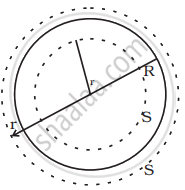Advertisements
Advertisements
प्रश्न
Consider a sphere of radius R with charge density distributed as
ρ(r) = kr for r ≤ R
= 0 for r > R
- Find the electric field at all points r.
- Suppose the total charge on the sphere is 2e where e is the electron charge. Where can two protons be embedded such that the force on each of them is zero. Assume that the introduction of the proton does not alter the negative charge distribution.
उत्तर
a. The symmetry of the problem suggests that the electric field is radial. For points r < R, consider a spherical Gaussian surface. Then on the surface

`oint E_r * dS = 1/ε_0 int_v ρdv`
`4pir^2 E_r = 1/ε_0 4pik int_0^r r^('3) dr^'`
= `1/ε_0 (4pik)/4 r^4`
∴ `E_r = 1/(4ε_0) kr^2`
`E_r = 1/(4ε_0) kr^2 hatr`
For points r > R, consider a spherical Gaussian surfaces’ of radius r,
`oint E_r * dS = 1/ε_0 int_v ρdv`
`4pir^2 E_r = (4pik)/ε_0 int_0^r r^3 dr^`
= `(4pik)/ε_0 R^4/4`
∴ `E_r = k/(4ε_0) R^4/r^2`
`E_((r)) = (k/(4ε_0)) (R^4/r^2)hatr`
b. The two protons must be on the opposite sides of the centre along a diameter. Suppose the protons are at a distance r from the centre.

Now, `4pi int_0^R kr^('3)dr = 2e`
∴ `(4pik)/4 R^4 = 2e`
∴ `k = (2e)/(piR^4)`
Consider the forces on proton 1. The attractive force due to the charge distribution is
`-eE_r = - e/(4ε_0) kr^2 hatr = - (2e^2)/(4piε_0) r^2/R^4 hatr`
The repulsive force is `e^2/(4piε_0) 1/(2r)^2 hatr`
Net force is `(e^2/(4 piε_0 4r^2) - (2e^2)/(4piε_0) r^2/R^4)hatr`
This is zero such that `e^2/(16 piε_0 4r^2) = (2e^2)/(4piε_0) r^2/R^4`
Or, `r^4 = (4R^4)/32 = R^4/8`
⇒ `r = R/(8)^(1/4)`
Thus, the protons must be at a distance `r = R/root(4)(8)` from the centre.
APPEARS IN
संबंधित प्रश्न
Electric intensity outside a charged cylinder having the charge per unit length 'λ' at a distance from its axis is ________.
(a) E = `(2pi in_0 lambda)/(Kr^2)`
(b) E = `(in_0 lambda)/(2piKr^2)`
(c) E = `lambda/(2piin_0Kr)`
(d) E = `(4piin_0lambda)/(Kr^2)`
If the point charge is now moved to a distance 'd' from the centre of the square and the side of the square is doubled, explain how the electric flux will be affected.
Use Gauss' law to derive the expression for the electric field `(vecE)` due to a straight uniformly charged infinite line of charge density λ C/m.
Draw a graph to show the variation of E with perpendicular distance r from the line of charge.
Find the work done in bringing a charge q from perpendicular distance r1 to r2 (r2 > r1)
A spherical ball contracts in volume by 0.02% when subjected to a pressure of 100 atmosphere. Assuming one atmosphere = 105 Nm−2, the bulk modulus of the material of the ball is:
- Obtain the expression for the electric field intensity due to a uniformly charged spherical shell of radius R at a point distant r from the centre of the shell outside it.
- Draw a graph showing the variation of electric field intensity E with r, for r > R and r < R.
An infinitely long positively charged straight wire has a linear charge density λ. An electron is revolving in a circle with a constant speed v such that the wire passes through the centre, and is perpendicular to the plane, of the circle. Find the kinetic energy of the electron in terms of the magnitudes of its charge and linear charge density λ on the wire.
Draw a graph of kinetic energy as a function of linear charge density λ.
